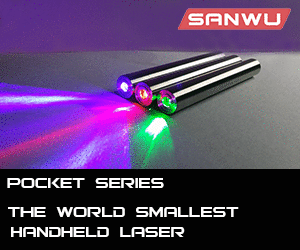wizard
0
- Joined
- Jul 18, 2013
- Messages
- 12
- Points
- 0
After spending a few days looking at quite a few very impressive builds posted here on LPF, I decided to design & build a rather different looking host. I wanted my laser to have around 2W to 3W and be as compact and portable as I could make it. I decided to go with a 9mm; I purchase the LED-Lens-Driver assembly (G-2-LFL) from DTR which simply worked great right out of the box. The following photos document the build...
Start with a 1" x 1.75" x 12" piece of 6061 Aluminum, and keep milling until you find the finished host.

The bottom view shows a few grooves which I milled into the beveled corners to provide a better gripping area, a few cooling fins, and the set-screw to hold the LED in place.

The X-drive board is mounted just behind the LED. The little red button is the main on-off push button switch.

The two 18650 batteries are wired in series and fit into two 3/4" drilled holes. You can also see the open battery access door.

The battery access door was one of the harder parts to make as it also contains a small spring operated latch. I salvaged the tiny spring from a Bic lighter. The smallest pins were cut from paper clips. The battery contact springs were salvaged from cheap LED flashlights.

The slide switch connects/opens the two batteries and acts as a "safety" switch to help prevent accidental "on" conditions. (Looking at this photo makes me want to go back and clean up the edges of the switch opening a bit better.)

Here's a look at the front end. The focus ring is recessed to protect it from accidental movement.

The final product!!!

Start with a 1" x 1.75" x 12" piece of 6061 Aluminum, and keep milling until you find the finished host.

The bottom view shows a few grooves which I milled into the beveled corners to provide a better gripping area, a few cooling fins, and the set-screw to hold the LED in place.

The X-drive board is mounted just behind the LED. The little red button is the main on-off push button switch.

The two 18650 batteries are wired in series and fit into two 3/4" drilled holes. You can also see the open battery access door.

The battery access door was one of the harder parts to make as it also contains a small spring operated latch. I salvaged the tiny spring from a Bic lighter. The smallest pins were cut from paper clips. The battery contact springs were salvaged from cheap LED flashlights.

The slide switch connects/opens the two batteries and acts as a "safety" switch to help prevent accidental "on" conditions. (Looking at this photo makes me want to go back and clean up the edges of the switch opening a bit better.)

Here's a look at the front end. The focus ring is recessed to protect it from accidental movement.

The final product!!!

Last edited:



